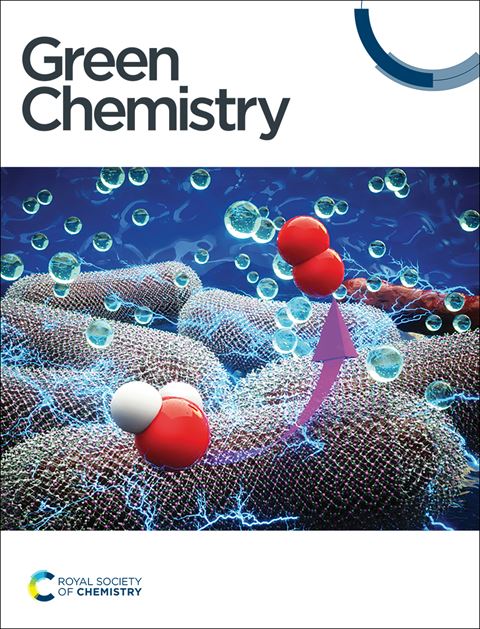调节SnS2疏水微环境,促进界面CO2/H2O比向ph通用型电催化CO2还原†方向发展
IF 9.3
1区 化学
Q1 CHEMISTRY, MULTIDISCIPLINARY
引用次数: 0
摘要
电催化CO2还原制甲酸是一种很有前途的获得高附加值化学品和实现碳循环的策略。然而,它的实际应用通常受到二氧化碳接近催化剂表面的限制以及缺乏在不同pH水平下有效的通用催化剂的阻碍。在此,我们报道了一种新的催化剂,即SnS2修饰的疏水聚合物聚偏氟乙烯(SnS2 + PVDF),用于在流动电池中在宽pH范围内有效地电催化CO2还原为甲酸/甲酸。该催化系统在碱性(98%)、中性(86%)和酸性(93%)电解质中都具有显著的法拉第效率。在酸性电解质中,单次碳效率可达72.77%。水接触角测量与原位衰减全反射表面增强红外吸收光谱结果表明,PVDF的包裹形成疏水微环境,增加了SnS2颗粒表面附近的CO2/H2O比。因此,SnS2颗粒表面周围的CO2浓度增加,形成许多三相(固-液-气)边界。原位拉曼光谱结合电催化研究表明,SnS2在反应过程中发生重构,形成具有催化活性的Sn/SnS2。这些发现确保并扩大了疏水微环境调节策略在促进电催化CO2还原为甲酸中的普遍性。本文章由计算机程序翻译,如有差异,请以英文原文为准。
Regulating the hydrophobic microenvironment of SnS2 to facilitate the interfacial CO2/H2O ratio towards pH-universal electrocatalytic CO2 reduction†
Electrocatalytic CO2 reduction to formic acid is a promising strategy to obtain value-added chemicals and achieve the carbon cycle. However, its practical application is generally impeded by the limited accessibility of CO2 to the catalyst's surface and the lack of an efficient universal catalyst across different pH levels. Herein, we report a new catalyst, i.e., SnS2 decorated with a hydrophobic polymer polyvinylidene fluoride (SnS2 + PVDF), for the effective electrocatalytic CO2 reduction to formate/formic acid across a wide pH range in a flow cell. This catalytic system accomplishes a remarkable faradaic efficiency for the formic acid production in alkaline (98%), neutral (86%), and acidic (93%) electrolytes. Also, the single-pass carbon efficiency reaches up to 72.77% in acidic electrolytes. Water contact angle measurements in association with in situ attenuated total reflectance surface-enhanced infrared absorption spectroscopy results indicate that the inclusion of PVDF creates a hydrophobic microenvironment which increases the CO2/H2O ratio near the surface of SnS2 particles. As a consequence, SnS2 particles enjoy the enhanced CO2 concentration around their surface to form many three-phase (solid–liquid–gas) boundaries. In situ Raman spectra combined with electrocatalytic studies reveal that SnS2 undergoes reconstitution to form catalytically active Sn/SnS2 during the reaction. These findings ensure and expand the generality of a hydrophobic microenvironment regulation strategy in promoting electrocatalytic CO2 reduction to formic acid.
求助全文
通过发布文献求助,成功后即可免费获取论文全文。
去求助
来源期刊

Green Chemistry
化学-化学综合
CiteScore
16.10
自引率
7.10%
发文量
677
审稿时长
1.4 months
期刊介绍:
Green Chemistry is a journal that provides a unique forum for the publication of innovative research on the development of alternative green and sustainable technologies. The scope of Green Chemistry is based on the definition proposed by Anastas and Warner (Green Chemistry: Theory and Practice, P T Anastas and J C Warner, Oxford University Press, Oxford, 1998), which defines green chemistry as the utilisation of a set of principles that reduces or eliminates the use or generation of hazardous substances in the design, manufacture and application of chemical products. Green Chemistry aims to reduce the environmental impact of the chemical enterprise by developing a technology base that is inherently non-toxic to living things and the environment. The journal welcomes submissions on all aspects of research relating to this endeavor and publishes original and significant cutting-edge research that is likely to be of wide general appeal. For a work to be published, it must present a significant advance in green chemistry, including a comparison with existing methods and a demonstration of advantages over those methods.
 求助内容:
求助内容: 应助结果提醒方式:
应助结果提醒方式:


